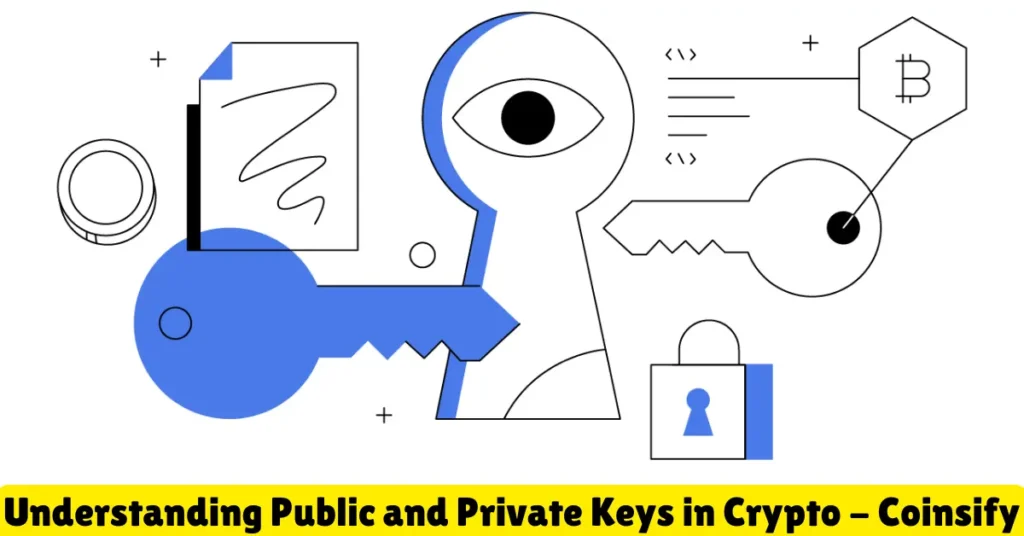Understanding Public and Private Keys in Crypto
Introduction
When people first start exploring cryptocurrency, they often hear about “public keys” and “private keys.” These terms might sound technical or confusing at first, but they’re the foundation of how crypto works securely.
Think of it this way: Just like you need a key to unlock your door at home, you also need special digital keys to send or receive cryptocurrency. These keys are what keep your crypto safe and make sure only you can access your digital wallet.
In this blog post, we’ll break down what public and private keys are, how they work together, and why they’re so important in the world of crypto. Don’t worry — we’ll keep things simple, clear, and easy to understand, even if you’re brand new to the topic.
What Are Cryptographic Keys?
Cryptographic keys are a basic but powerful part of how cryptocurrency works. In simple words, these are special codes that help keep your digital assets safe and secure.
There are two types of cryptographic keys used in crypto — public keys and private keys. Together, they form what is called a key pair.
These keys are used in a system called cryptography, which is like digital secret-keeping. Cryptography makes sure that only the right person can access or move the crypto stored in a wallet.
Here’s how they work:
- The public key is used to receive cryptocurrency.
- The private key is used to access and send cryptocurrency.
Without these keys, it’s impossible to make secure crypto transactions. That’s why they are the heart of blockchain security and user ownership.
The Concept of Key Pairs
In cryptocurrency, public and private keys are always created as a pair, and they work together like a team. This is called a key pair.
A key pair is made up of:
- One public key, which you can share with others.
- One private key, which you must keep secret.
These two keys are mathematically linked, meaning they are created together and specially match each other. Even though they are connected, you can’t figure out the private key just by knowing the public one — and that’s what makes this system secure.
Think of it like this:
- The public key is like your email address — people can use it to send you messages (or crypto).
- The private key is like your email password — it lets you read those messages and send replies (or access and send your crypto).
- This key pair system is based on something called asymmetric encryption, which sounds complex, but simply means that two different keys are used: one for locking (public) and one for unlocking (private).
So when someone sends you crypto, they use your public key. But only you can unlock and access it using your private key.
What is a Public Key?
A public key is one half of your cryptographic key pair. It’s a unique code that is used to receive cryptocurrency. You can think of it as your crypto address — something you can safely share with others.
Here’s what makes a public key important:
- It is generated automatically when you create a crypto wallet.
- You can share it freely with anyone who wants to send you cryptocurrency.
It helps people identify where to send the funds, similar to how someone needs your bank account number to transfer money.
For example, if your friend wants to send you Bitcoin, they’ll need your public key (or wallet address, which is often a shortened version of your public key). They enter it into their wallet, send the amount, and the transaction is recorded on the blockchain.
Even though this key is public, it cannot be used to access your funds — that’s the job of the private key. So, sharing your public key is completely safe, and it’s the only way others can send crypto to your wallet.
In short, your public key is like a digital mailbox — anyone can drop a letter (crypto) in it, but only you can unlock and open it with your private key.
What is a Private Key?
A private key is the most important part of your crypto wallet — it’s a secret code that gives you full control over your cryptocurrency. While your public key is meant to be shared, your private key must be kept safe and never revealed to anyone.
Here’s why the private key is so important:
- It allows you to access your crypto funds.
- It is used to sign transactions, proving that you are the true owner of the wallet.
- Without the private key, you cannot send or move your cryptocurrency.
Think of your private key like your ATM PIN or email password. Even if someone knows your account number (public key), they still can’t do anything unless they also have your password (private key).
Your private key is usually a long string of letters and numbers, or sometimes stored in the form of a seed phrase (a list of 12 or 24 words). If you lose this key or phrase, you could permanently lose access to your crypto, because there’s no reset or recovery option like with traditional banking.
In summary, your private key is what proves ownership of your cryptocurrency. Keep it safe, store it offline if possible, and never share it with anyone — not even someone claiming to be from a crypto support team.
How Do Public and Private Keys Work Together?
Public and private keys are like a lock-and-key system — they are designed to work together to keep your cryptocurrency safe and to make secure transactions possible.
Here’s how they function as a team:
Receiving Crypto
- When someone wants to send you cryptocurrency, they use your public key (or wallet address).
- Think of your public key as the “lock” — it lets people know where to send the funds.
- Since it doesn’t reveal any private info, it’s safe to share.
Sending or Accessing Crypto
- To access or send your crypto, you must use your private key.
- Your private key is the “key” that unlocks the funds.
- It proves that you are the real owner of the wallet and have the right to make transactions.
Digital Signatures
- Every time you send crypto, your private key creates a digital signature.
- This signature confirms that the transaction is authentic and wasn’t made by someone else.
- The blockchain verifies this using your public key, without ever exposing your private key.
Real-World Example
Imagine you have a mailbox (your wallet):
- Anyone can drop a letter (crypto) into it using the address (your public key).
- But only you have the key (your private key) to open the mailbox and use what’s inside.
In short, public and private keys work together to secure your funds. The public key lets others send you crypto, and the private key allows you to access and control it. Without both parts, the system wouldn’t function, and your security would be at risk.
Real-Life Analogies (To Simplify the Concept)
Sometimes, technical concepts like public and private keys become easier to understand when we compare them to things we use in everyday life. Here are a few real-world examples to help you grasp how these keys work:
Lock and Key
- Public Key = Lock (visible to everyone)
- Private Key = Key (only you have it)
Anyone can see the lock and try to put something inside (send crypto), but only the person with the key (private key) can unlock it and take what’s inside.
Email Address and Password
- Public Key = Email Address
- Private Key = Email Password
You can share your email address with others so they can send you messages. But your password must stay secret because it gives full access to your inbox, just like your private key gives access to your wallet.
Signature and Identity
- Private Key = Your Handwriting/Signature
- Public Key = The Record Used to Verify
When you sign a document, only you can create your exact signature (private key). But others can verify if it’s truly yours by comparing it with your known signature on file (public key). This is how digital signatures work in crypto too.
Bank Account and PIN
- Public Key = Bank Account Number
- Private Key = PIN or Password
You can give someone your bank account number to receive money. But only you, with the correct PIN or password, can withdraw or transfer funds — just like your private key gives access to your crypto.
These examples show how public and private keys work together, with one part shared openly and the other kept private to maintain control and security. When you understand this relationship, crypto becomes much easier to manage safely.
Importance of Key Security
In the world of cryptocurrency, your private key is everything. If someone gets access to your private key, they can take full control of your funds, and there’s no way to reverse or recover those transactions. That’s why key security is not just important — it’s essential.
Here’s what you need to know about keeping your keys safe:
If You Lose Your Private Key, You Lose Your Crypto
Unlike traditional banking, there’s no customer service or “forgot password” option in crypto. If you lose your private key (or seed phrase), you permanently lose access to your wallet and all the funds in it.
If Someone Else Gets Your Private Key, They Can Steal Everything
Anyone who has your private key can:
- Access your wallet
- Send your crypto to another address
- Drain your funds in seconds
That’s why you should never share your private key with anyone, not even someone claiming to be from a support team.
Use Safe Storage Methods
There are different ways to keep your keys secure:
- Cold Wallets (Offline): These are hardware wallets or paper wallets that store your keys offline, away from hackers and online threats.
- Hot Wallets (Online): Convenient for trading, but more vulnerable to hacks. Only keep small amounts in these.
- Seed Phrase Backups: Write down your recovery phrase on paper and store it in a safe place. Never store it online or take a photo of it.
Be Aware of Scams and Phishing
Many people lose their crypto not through hacking, but by falling for fake websites, apps, or messages that trick them into revealing their private key. Always double-check URLs, use trusted apps, and never enter your key anywhere online unless you are 100% sure it’s safe.
In short, the security of your keys = the security of your crypto. Treat your private key like cash or gold — because in the crypto world, that’s exactly what it is.
Common Misconceptions
When it comes to public and private keys in crypto, many beginners have some misunderstandings. Let’s clear up a few of the most common myths:
“I can recover my private key if I lose it.”
Wrong.
- Once your private key (or recovery phrase) is lost, there’s no way to recover it — not even the wallet company can help. That’s why backing it up securely is critical.
“My coins are stored in my wallet.”
Not exactly.
- Your wallet doesn’t store your coins — it stores your keys. Your actual crypto is recorded on the blockchain, and your private key gives you access to it.
“Public keys can be used to hack my wallet.”
False.
- Public keys are safe to share. They are designed to receive funds and cannot be used to access or steal your crypto. The danger lies only in exposing your private key.
“I can use the same key pair across all cryptocurrencies.”
Not always.
- Each blockchain (like Bitcoin, Ethereum, etc.) may have its own key format and wallet system. Some wallets support multiple chains, but using the same key across different platforms can create risks if not managed properly.
“Private keys are the same as passwords.”
Partly true.
- While they serve a similar purpose (giving access), private keys are much longer and more complex. They are usually generated automatically and are not meant to be memorized like a regular password.
Understanding these misconceptions can help you avoid costly mistakes and keep your crypto journey secure and smooth. Always double-check information, and never assume crypto works like traditional banking, because it doesn’t.
Step-by-Step Guide: Understanding Public and Private Keys in Crypto
Step 1: Learn What Cryptographic Keys Are
- Start by knowing that cryptographic keys are special codes that protect your cryptocurrency. They come in pairs — a public key and a private key — and they work together to secure your digital assets.
Step 2: Understand the Public Key
- The public key is like your crypto address. It’s safe to share and is used by others to send you cryptocurrency. You can think of it as your bank account number or email address.
Step 3: Understand the Private Key
- The private key is a secret code only you should know. It lets you access your funds and approve transactions. Think of it like your ATM PIN or email password — keep it safe and never share it.
Step 4: Know How the Key Pair Works Together
- Your public key allows others to send crypto to you, while your private key lets you unlock and spend that crypto. This pairing is based on complex math, which ensures security and trust in transactions.
Step 5: Create Your Crypto Wallet
- When you create a cryptocurrency wallet, it automatically generates your key pair. The public key is your receiving address, and the private key is your access tool. Always save your private key or seed phrase securely.
Step 6: Use Your Public Key to Receive Crypto
- Share your public key (or wallet address) with anyone who wants to send you cryptocurrency. They will use this key to transfer funds to your wallet.
Step 7: Use Your Private Key to Send Crypto
- When you want to send cryptocurrency, you use your private key to sign the transaction, proving that you own the funds. This step is essential to authorize moving crypto from your wallet.
Step 8: Keep Your Private Key Safe
- Protect your private key like cash or valuable documents. Use hardware wallets or offline storage (cold wallets) for better security. Avoid sharing it online or storing it on easily hacked devices.
Step 9: Backup Your Seed Phrase
- Most wallets give you a seed phrase (a list of words) to recover your private key if you lose access. Write it down and keep it somewhere safe and private. Don’t store it digitally where hackers can reach it.
Step 10: Be Aware of Scams and Phishing Attempts
- Never share your private key or seed phrase with anyone. Be cautious about suspicious emails, websites, or apps asking for your keys. Always use official wallet software and double-check URLs.
Step 11: Understand You Are Responsible
- In cryptocurrency, you are your bank. If you lose your private key or get hacked, there is no way to reverse the transaction or get help from a central authority. So, understanding and protecting your keys is crucial.
Step 12: Keep Learning and Stay Updated
- Crypto technology evolves quickly. Keep learning about security best practices and new wallet features to stay safe and make the most of your digital assets.
This step-by-step guide gives you a strong foundation to understand and safely use public and private keys in cryptocurrency. Following these steps will help you confidently manage your crypto assets without unnecessary risks.
Common FAQs About Public and Private Keys in Crypto
Q1: What is a public key in cryptocurrency?
A public key is like your crypto address. It’s a code you can share with others so they can send you cryptocurrency safely.
Q2: What is a private key?
A private key is a secret code that lets you access and control your cryptocurrency. You must keep it private and never share it with anyone.
Q3: Can someone steal my crypto if they get my public key?
No. Your public key is safe to share and cannot be used to steal your crypto. Only the private key gives access to your funds.
Q4: What happens if I lose my private key?
If you lose your private key or seed phrase, you lose access to your cryptocurrency forever. There is no way to recover it, so backing it up is very important.
Q5: Can I use the same public and private keys for different cryptocurrencies?
Not always. Different cryptocurrencies often use different key formats. Make sure you use the right wallet for each crypto.
Q6: How do public and private keys work together?
The public key is used to receive crypto, while the private key is used to send or access that crypto. They work as a pair to keep your funds safe.
Q7: Is my private key like a password?
Yes, but much longer and more complex. It’s a unique code generated for your wallet and gives you full control over your crypto.
Q8: Can I share my private key with a trusted person?
It’s not recommended. Sharing your private key means giving full access to your funds, which is risky.
Q9: How can I keep my private key safe?
Store it offline in a secure place, use hardware wallets, and keep a written backup of your seed phrase. Avoid saving it on computers or phones connected to the internet.
Q10: What is a seed phrase?
A seed phrase is a list of words that can help you recover your private key if you lose it. Keep it safe and private.
If you have more questions or want to know about other crypto topics, feel free to ask!
Conclusion
Understanding public and private keys is key to safely using cryptocurrency. Your public key lets others send you crypto, while your private key gives you control over your funds. Always keep your private key secure and never share it. With these basics, you can confidently manage your crypto and enjoy the benefits of this exciting technology.
Bonus Points
- Use Hardware Wallets for Extra Security: Hardware wallets store your private keys offline, making them much safer from hackers than online wallets.
- Enable Two-Factor Authentication (2FA): Adding 2FA to your crypto accounts adds more protection beyond just your keys.
- Regularly Update Your Wallet Software: Wallet providers often release updates that improve security and fix bugs. Keeping your software updated helps protect your funds.
- Be Careful with Public Wi-Fi: Avoid accessing your crypto wallets over public Wi-Fi networks to reduce the risk of hacking.
- Learn About Multi-Signature Wallets: These wallets require multiple private keys to authorize a transaction, which adds extra security for managing funds.
- Practice Safe Backup Habits: Store backup copies of your seed phrase or private key in multiple secure locations to prevent loss.
- Stay Informed About Scams: Scammers often target private keys with phishing attempts. Always double-check sources and never share your keys.
Also read
- What is a Crypto Wallet and How Does It Work? – Coinsify
- 10 Crypto Terms Every Beginner Must Know – Coinsify
- What is Blockchain Technology – Complete Guide – Coinsify
- How to Buy Crypto Safely in 2025 – Complete Guide – Coinsify
- Bitcoin vs Ethereum: Key Differences Explained – Complete Guide
- Ultimate Blockchain Glossary: Learn Blockchain Terms Easily
- How to Buy Bitcoin Safely (Complete Beginner’s Guide)
- Top 10 Crypto Wallets for Beginners (2025 Edition)
- What is Cryptocurrency? A Beginner-Friendly Guide (2025)






